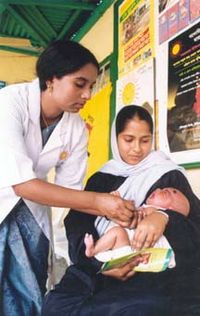
Photo from wikipedia
BackgroundBreast cancer screening mammography is widespread in industrialised countries within the framework of public health program or opportunist form. Only few data exist on the comparison of effectiveness between organised… Click to show full abstract
BackgroundBreast cancer screening mammography is widespread in industrialised countries within the framework of public health program or opportunist form. Only few data exist on the comparison of effectiveness between organised and opportunistic screening. The aim of this study is to compare organised and opportunistic screening using population-based data from the Fribourg cancer registry, Switzerland.MethodsWe included all first primary breast adenocarcinoma diagnosed between 2006 and 2014 in women aged 50–69 years resident in the canton of Fribourg. We considered only breast cancer discovered by mammography screening. We compared patients, tumour characteristics and treatment modalities between breast cancer detected by the organised screening program versus opportunistic screening using logistic regression.ResultsOut of 989 patients diagnosed with breast cancer, 402 (40.6%) were diagnosed by organised and 205 (20.7%) by opportunistic screening. Women with breast cancer detected within the screening program were more likely to be from rural areas (P = 0.035) and lived less frequently in high favoured regions (P = 0.020). They presented more frequently in situ than invasive cancer (P = 0.022). For patients with invasive breast cancer, those detected by the program were less likely to undergo mastectomy (P = 0.06) and consequently, they were more likely to undergo radiation therapy (P = 0.003). Adjustment for area of residence and financial context of the region did not modify the results presented.ConclusionsThe present study reports an increased rate of detection of carcinoma in situ in organised screening program as compared to opportunistic screening mammographies, an indirect evidence of a higher radiologic sensitivity. Furthermore, the results show a trend towards more mastectomies among patients with breast cancer discovered after opportunistic than after organized mammography screening, reflecting lower treatment burden. Those results were independent of socio-economic factors which differed across screening groups.
Journal Title: BMC Cancer
Year Published: 2019
Link to full text (if available)
Share on Social Media: Sign Up to like & get
recommendations!